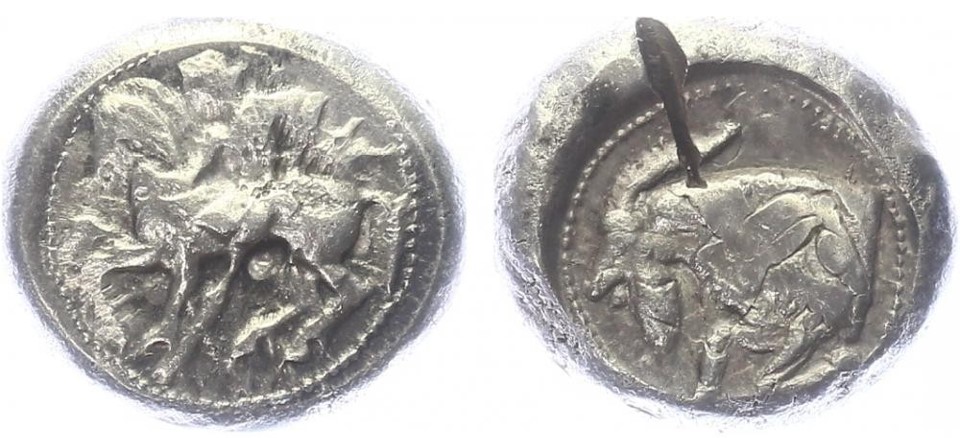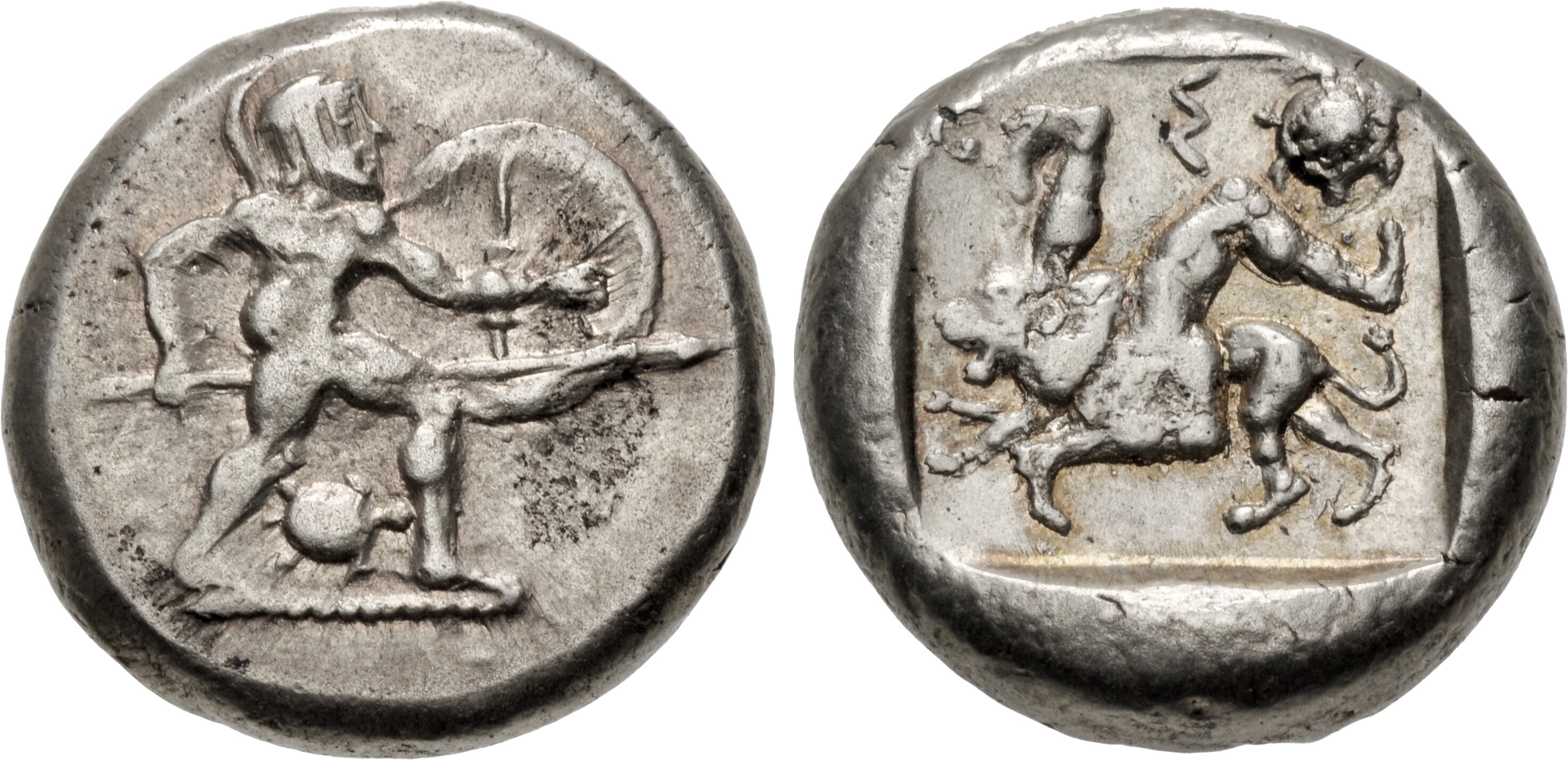26770 - Celenderis (double siglos youth dismounting horse/goat) over Aspendus (hoplite/triskeles) (Aurea Numismatika, EA 25, Sept. 2020, 3125)
From SILVER
410 BCE - 365 BCE | KEΛ
Location/history
| Sale(s)Sale(s) ᵖ: | AUREA Numismatika, EA 25, 6 Sept. 2020, 3125 | |
Overstriking coin
Description
| ObverseInscription or printing placed on the obverse.: | Nude youth, holding whip in right hand, dismounting from horse rearing right | ReverseInscription or printing placed on the reverse.: | KEΛ (Greek) Goat kneeling left, head right, KEΛ and ivy leaf above, Π to left, all within shallow incuse circle |
Mint and issuing power
| MintIdentifies the place of manufacture or issue of a numismatic object.: | Celenderis | Ancient regionAncient region. | Cilicia | Modern countryModern country: Turkey | AuthorityIdentifies the issuing power. The authority can be "pretended" when the name or the portrait of X is on the coin but he/she was not the issuing power. It can also be "uncertain" when there is no mention of X on the coin but he/she was the issuing power according to the historical sources: | Persian Empire |
Chronology
| FromIdentifies the initial date in a range assigned in a numismatic context. 410 BCE toIdentifies the final date in a range assigned in a numismatic context.. 365 BCE | Classical 480-323 BC |
Physical description
| MetalThe physical material (usually metal) from which an object is made.: Silver |
DenominationTerm indicating the value of a numismatic object. Examples: tetradrachm, chalkous, denarius.: double siglos |
||
| StandardStandard.: Persian | |||
References
| Coin referenceReference of the Coin: | Coin series referenceReference to coin series study: | Kraay 19621Kraay 1962, p. 3-6, Sear II2Sear II, n° 5533-5535 | |
| Coin series web referenceCoin series web references: | |||
Overstruck type
Description
| ObverseInscription or printing placed on the obverse.: | Warrior advancing right, holding shield in his left hand and spear in his right hand. | ReverseInscription or printing placed on the reverse.: | Lion walking left surmounted by a triskeles within incuse square |
Mint and issuing power
| MintIdentifies the place of manufacture or issue of a numismatic object. ᵖ: | Aspendus | Ancient regionAncient region. ᵖ | Pamphylia | Modern countryModern country: Turkey | AuthorityIdentifies the authority in whose name (explicitly or implicitly) a numismatic object was issued. ᵖ: | Persian Empire |
Chronology
| FromIdentifies the initial date in a range assigned in a numismatic context. 463 BCE toIdentifies the final date in a range assigned in a numismatic context.. 430 BCE | Classical 480-323 BC |
Physical description
| DenominationTerm indicating the value of a numismatic object. Examples: tetradrachm, chalkous, denarius. ᵖ: | double siglos |
StandardStandard. ᵖ: | Persian |
References
| Coin type referenceReference to coin series study ᵖ: | Babelon 19013Babelon 1901, Part 2, Tome 1, p. 526-530, n° 869-70, SNG von Aulock Pamphylien4SNG von Aulock Pamphylien, n° 4484, SNG France 35SNG France 3, n° 12-13 | ||
| Coin series web reference overstruckCoin series web references overstruck: | |||
Additional data
| Frequency of overstrikesFrequency of overstrikes: | exceptional | Level of confidenceLevel of confidence of the identification: | strong |
| RemarksRemarks: | nb: no mention of overstrike (info and identification given by Petr Vesely) | ||
References
- ^ Kraay, Colin M. (1962), "The Celenderis Hoard," Numismatic Chronicle, 7 (2), p. 1-16, pl. 1-2.
- ^ Sear, David R. (1979), Greek coins and their values. Vol. II, Asia and North Africa, London, xlviii, p. 317-762
- ^ Babelon, Ernest (1901), Traité des monnaies grecques et romaines. Tome Premier. Première partie, théorie et doctrine, Paris, E. Leroux
- ^ Sylloge Nummorum Graecorum. Sammlung v. Aulock. Pamphylien. 11 Heft (n° 4477-4893), Berlin, 1965.
- ^ Levante, Edoardo [with the collaboration of Peter Weiss] (2001), Sylloge nummorum graecorum. France. 3, Département des monnaies, médailles et antiques : Pamphylie, Pisidie, Lyaconie, Galatie, Paris-Zürich, Bibliothèque nationale de France-Numismatica Ars Classica, XXXIV + 293 p. and 146 pl.

